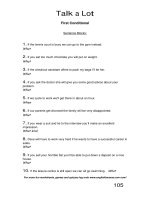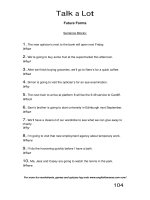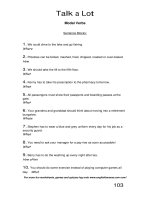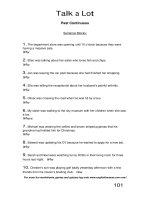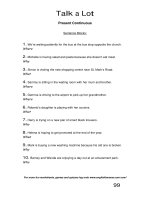talk a lot what is word stress
Bạn đang xem bản rút gọn của tài liệu. Xem và tải ngay bản đầy đủ của tài liệu tại đây (54.14 KB, 2 trang )
Talk a Lot
Focus on Connected Speech
What is Word Stress?
Every word in English has one syllable with a stronger stress than that of the others. English
is a stress-timed language, which means that we speak with rhythm, pronouncing the stress
in each content word. For example, in the word “teacher”, the first syllable is stressed and the
second syllable is unstressed. (See p.12.1 for more on content words.) The strong stress
always falls on a vowel sound. But which syllable and sound is stressed in each word?
There are many complicated and obscure rules for finding word stress in English words, like:
“Two-syllable adjectives (without prefixes) are always stressed on the first syllable (or
sometimes the second if the word begins with a vowel), unless there is an “R” in the
month, or it’s later than 8pm in the evening on a market day (during a wet fortnight in
Wales)…” etc.
OK, I’m only joking, but perhaps you can see what I’m trying to say here! Students can, of
course, explore word stress in more detail at their leisure (the bibliography on p.x could help).
However, in this handbook I would like to highlight a few dead-cert rules:
1. First Syllable Drift
In English most words tend to be stressed on the first syllable. Around 83% of the 1,000 most
commonly-used words have Germanic origin, which is where this tendency comes from1. For
example, of the 201 single discussion words with two or more syllables in Talk a Lot
Elementary Book 2, 154 were stressed on the first syllable – that’s 77%. For more analysis of
discussion words from this book, see p.13.3.
2. Suffixes
Suffixes are the end parts of words, like -able (believable), -ful (helpful), -ing (eating), -ment
(arrangement), etc. Suffixes are almost always unstressed, so if students find a two syllable
word with a suffix, e.g. “playing”, they can be 99% sure that the first syllable is stressed:
playing = LDéäÉfàKfÏL As if this information wasn’t already a big enough help for working out
word stress, there are many common suffixes where the strong stress is always on the
preceding syllable, for example: -able, -ation, -asion, and -ment. For more examples, see
p.15.4. As with most things in English grammar there are a few exceptions to the rule, e.g.
words ending in certain suffixes are always stressed on the suffix (see p.15.4). For example,
words ending in “-ee”, like referee LêÉÑK]DêáWL , are always stressed on the suffix. For more on
suffixes see p.15.1.
3. Compound Nouns
Compound nouns are nouns (things) that consist of two words together, for example: baseball
(base + ball), guidebook (guide + book), popcorn (pop + corn), and wheelbarrow (wheel +
barrow), etc. Compound nouns are almost always stressed on the first syllable, so if students
find a new word which is a compound noun, like “strawberry”, they can be 99% sure that the
first syllable is stressed: strawberry = LDëíêlWKÄKêáWL There are, of course, a few exceptions to
1
M. Celce-Murcia, D. M. Brinton, J. M. Goodwin, Teaching Pronunciation, CUP, 1996, p.133
For more fun worksheets, games and quizzes log onto www.englishbanana.com now!
Talk a Lot Elementary
English Banana.com
13.1
Talk a Lot
Focus on Connected Speech
What is Word Stress?
the rule, for example: loudspeaker Lä~rÇDëéáWâK]L and policewoman Lé]DäáWëKïrKã]åL, which
are both stressed on the second syllable. For more on compound nouns see p.16.1.
4. Prefixes
Prefixes are the beginning parts of words, like anti- (which means against), multi- (which
means many), pre- (which means before), and tele- (which means remote). There aren’t
really any word stress rules for prefixes: sometimes they are stressed, sometimes they are
not. We can see some patterns, though, for example a group of two-syllable homographs
which can be both verbs and nouns, and which are stressed on the first syllable if they’re
nouns, and on the second syllable if they’re verbs (see p.14.3). Despite prefixes not helping
us much with working out word stress, it’s generally good for students to learn how to identify
them, partly because they can give clues about the meanings of words (e.g. “mini” = small, so
“minibus” = small bus). There are some activities about prefixes in section 14 (from p.14.1).
In summary then, most words in a normal English sentence will fall into one of three
categories:
i)
ii)
iii)
one-syllable words – the stress falls on the only vowel sound in each word
words with suffixes – for two syllable words the stress falls on the first
syllable; for longer words, we know that the suffix is almost always
unstressed
compound nouns – the stress almost always falls on the first syllable
For examples of this, see the analysis of discussion words from Talk a Lot Elementary Book 2
on p.13.3, and the analysis of a newspaper article on p.13.7. Students can use this
information to help them when working out word stress. When you factor in that most English
words are stressed on the first syllable it’s possible to correctly guess the word stress of many
words that you don’t already know. In short, if a student is unsure of where the word stress
falls, and they don’t have time to look up the word and check the stress mark in their
dictionary, they should go for the first syllable to have a good chance of getting it right.
For more fun worksheets, games and quizzes log onto www.englishbanana.com now!
Talk a Lot Elementary
English Banana.com
13.2



